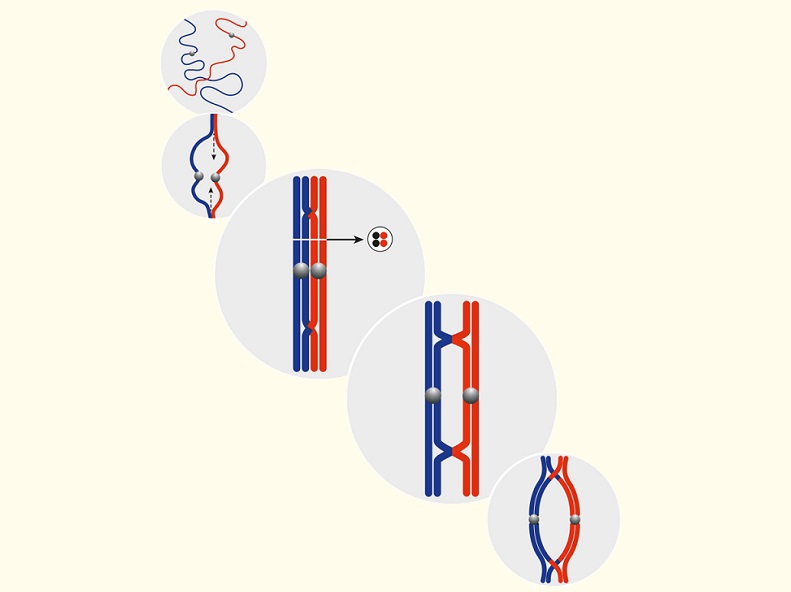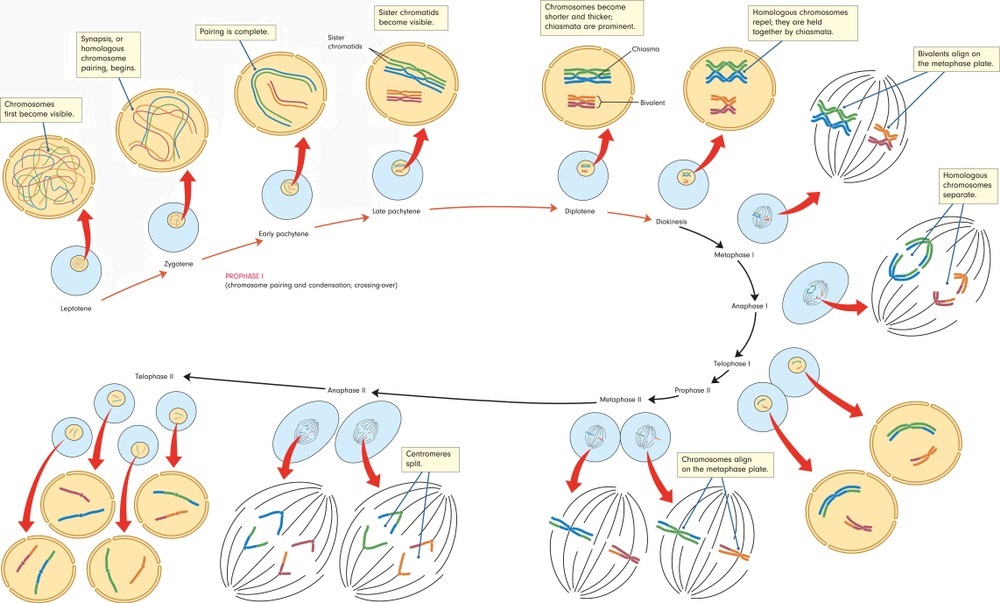Definition
Prophase I of meiosis I is a process that involves five different stages during which genetic material in the form of alleles crosses over and recombines to form non-identical haploid chromatids. Prophase I is the first stage of meiosis I, followed by prophase II, anaphase I, anaphase II, metaphase I and metaphase II.
Prophase I Glossary of Terms
In order to understand Prophase I of meiosis I, one should be familiar with the terms associated with this process. Meiosis only occurs in eukaryote cells. Eukaryote cells all contain genetic material in the form of DNA strands within the nucleus. These DNA strands are wound into chromatin which changes shape to form chromosomes during cell division.
Meiosis produces four haploid daughter cells from a diploid germline stem cell.
Diploid cells contain two sets of homologous (same) chromosomes. Diploid cells can produce exact copies of themselves via mitosis, or produce daughter cells with half of the genetic material under the process of meiosis.
In the two sets of homologous chromosomes (or homologs) of diploid cells, one comes from the father, the other from the mother. Mathematically, this is referred to as 2n, or two sets of homologous chromosomes. Scientific texts often extend this to 2n = 46. This refers to the 23 sets of human chromosomes. In diagrams where a full set of chromosomes do not all fit in, they may state 2n = 4, or 2n = 8. This simply refers to the number of chromosomes in that particular image.
As our cells have received information from both parents, we have the complete genetic information of both within our nuclear DNA. This means all of our diploid cells have 23 pairs of chromosomes. Diploid = Double.
Each chromosome is made up of two chromatids joined at the middle by a centromere. Each chromatid is identical. In the image below, number 1 depicts a single chromatid, 2 shows the centromere that joins both chromatids, 3 is the short (or ‘p’) arm and 4 the long (‘q’) arm of the chromosome.

Haploid refers to a gamete or sex cell – the spermatozoa in males and ova in females. Haploid cells only contain half of the genetic information of the parent cell, or ‘n’. This allows genetic material to merge upon the fertilization of an egg with sperm, creating a cell containing both parents’ DNA in a diploid cell. HAploid = HAlf.

It is also important to mention that chromosomes are a temporary formation. In the absence of cell division, DNA is packed into the nucleus and held together by binding proteins in a much less organized way as chromatin fibers. The X-shape of chromosomes can therefore only be seen at particular stages of cell division.
The Five Stages of Prophase I (Meiosis)
With a better understanding of the terminology, the complicated process of meiosis is much easier to understand. As already mentioned, meiosis I has five separate stages.
Stage 1: Leptotene
At this first stage of Prophase I of meiosis I chromosomes are visible under electron microscopy and look like ‘a string of beads’, where the beads are referred to as nucleosomes. If fully stretched out, some DNA may be nearly a centimeter long – much too large for a cell nucleolus. It is therefore packaged using special proteins. Core histones are the equivalent of sewing-thread spools around which the strand of DNA is coiled. When DNA has been twice wrapped around the core histone, it forms a structure known as the nucleosome. This gives the string of beads effect, with the unwound DNA giving the appearance of the string, and the wound nucleosomes the beads.
Each chromatid is extremely close to the other and this often gives the effect of a single chromosome. It is also understood that at the leptotene stage, double strand breaks in the DNA occur, preparing for recombination. Recombination is the result of a process in which the DNA of one chromatid is broken apart and mixed with another non-sister chromatid in order to produce a greater variety of alleles in the offspring. Recombination is the result of ‘crossing over’. Leptotene is often named in unison with the following stage as the Leptotene-Zygotene transition, as the first stage is in itself a very short process.
The image below shows all five stages of Prophase I, starting with leptotene at the top. You will notice the string of beads effect.

Stage 2: Zygotene
A tetrad, or two homologous chromosomes consisting of four chromatids, is connected to produce a chromosome pair during meiosis. In order to attach as a pair, a synapsis is formed. Ladder-like filaments bring together and attach the chromosome pair at a central point. These filaments make up the synaptonemal complex. Only once the pair has been connected can it be called a tetrad or bivalent. Crossing over can occur over the synaptonemal complex once it has formed, but in some organisms this complex is not obligatory for recombination.

Stage 3: Pachytene
Once a tetrad has formed, the process of crossing over and the resulting recombination can go ahead, where a little of the genetic material from the parental DNA sequences is swapped over to increase gene variation. At this point, the chromatid sisters (the two chromatid strands that make up a single chromosome) begin to separate from each other, although the chromosomes remain attached as a pair. This makes them much more distinctive under an electron microscope. The image below shows the crossing over of genetic material between two non-sister chromatids within a single homologous chromosome pair. The chiasma (plural: chiasmata) is the connecting point between two non-sister chromatids which allows for the exchange of alleles. Chiasmata can only form if the sister chromatids are separated from each other.

Stage 4: Diplotene
When the synaptonemal complex begins to break down, as it does during the diplotene stage, the chromosome pairs begin to move apart. However, they are unable to move far away from each other as they remain attached by the chiasmata. The repelling characteristic of the two chromosomes creates a preliminary shift towards the opposite poles of the as yet incomplete meiosis I spindle apparatus, which will be completed during the prometaphase 1 immediately following Prophase I.
Stage 5: Diakinesis
In diakinesis, the chiasmata connections arrive at the ends of the chromatid arms of the chromosome. This arrival is called terminalization. At this point, chromosomes are very condensed and still connected by chiasmata; they can not move any further towards the poles of the as yet incomplete spindle structure.
In order to prepare for the next phase in meiosis I, other structural changes occur. The nucleolus and nuclear envelope dissolve. This allows the centrioles (centrosome-forming microtubules) that contribute to spindle formation free to migrate, together with remnants of spindles formed during mitotic cell division. Microtubules in the cell cytoplasm are the predominant building blocks of spindle construction.
In the image below, the five stages of Prophase I can once again be seen, this time with the other processes of meiosis I. The representation of diakinesis clearly shows the chiasmata attachments and shift of the still-attached chromosomes pairs to opposite poles.

Quiz
